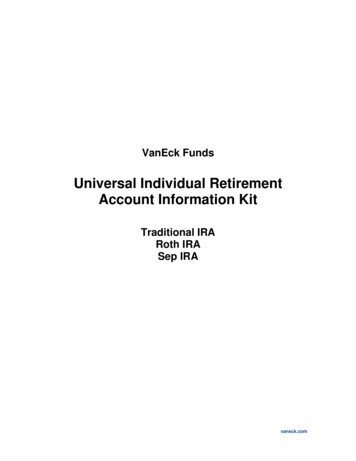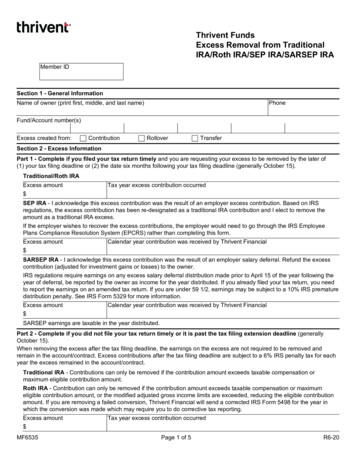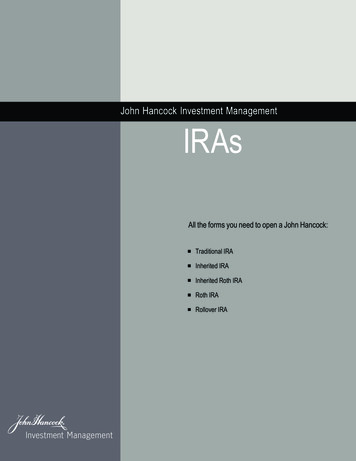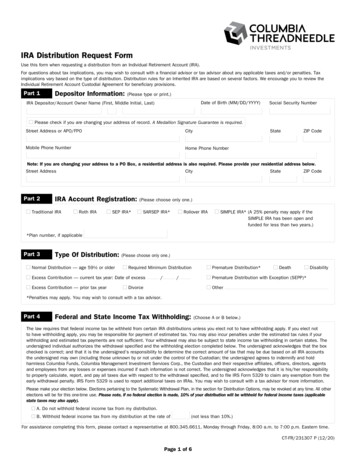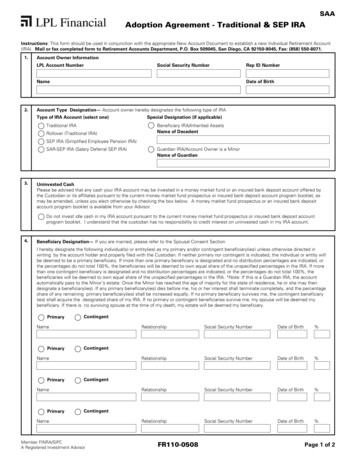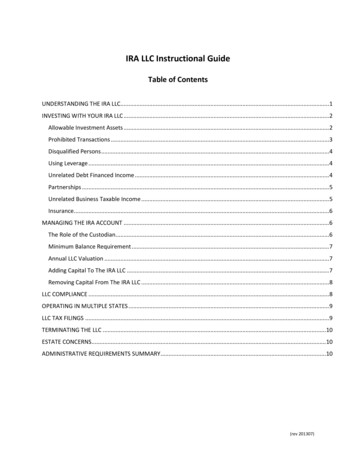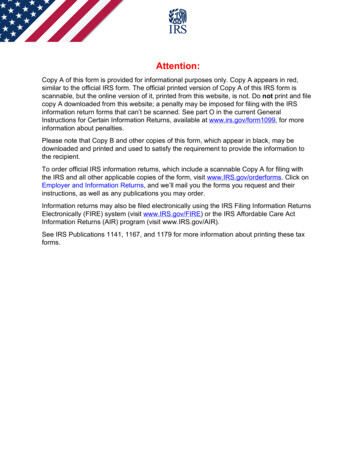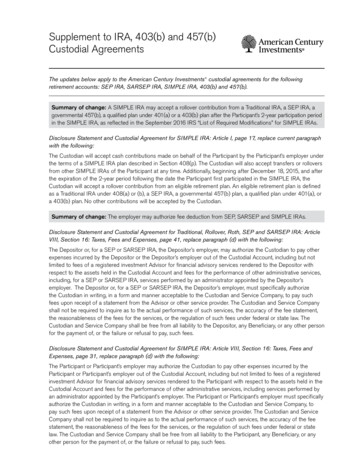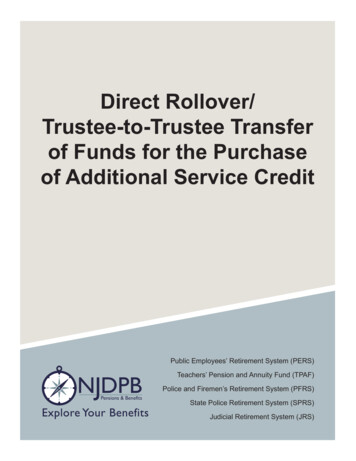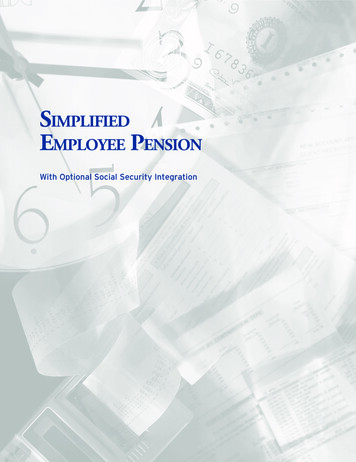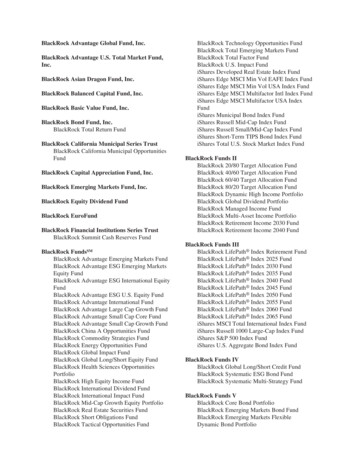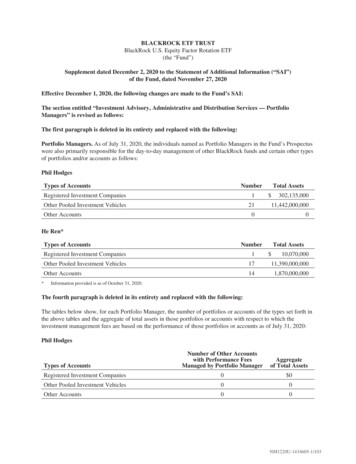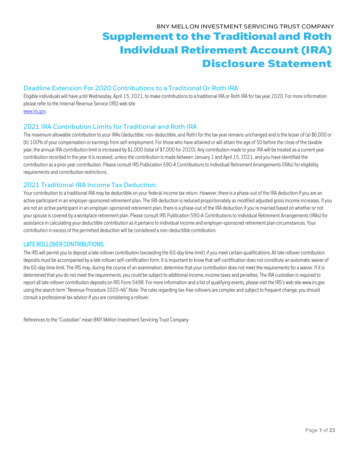
Transcription
BNY MELLON INVESTMENT SERVICING TRUST COMPANYSupplement to the Traditional and RothIndividual Retirement Account (IRA)Disclosure StatementDeadline Extension For 2020 Contributions to a Traditional Or Roth IRAEligible individuals will have until Wednesday, April 15, 2021, to make contributions to a traditional IRA or Roth IRA for tax year 2020. For more informationplease refer to the Internal Revenue Service (IRS) web sitewww.irs.gov.2021 IRA Contribution Limits for Traditional and Roth IRAThe maximum allowable contribution to your IRAs (deductible, non-deductible, and Roth) for the tax year remains unchanged and is the lesser of (a) 6,000 or(b) 100% of your compensation or earnings from self-employment. For those who have attained or will attain the age of 50 before the close of the taxableyear, the annual IRA contribution limit is increased by 1,000 (total of 7,000 for 2020). Any contribution made to your IRA will be treated as a current yearcontribution recorded in the year it is received, unless the contribution is made between January 1 and April 15, 2021, and you have identified thecontribution as a prior year contribution. Please consult IRS Publication 590-A Contributions to Individual Retirement Arrangements (IRAs) for eligibilityrequirements and contribution restrictions.2021 Traditional IRA Income Tax Deduction:Your contribution to a traditional IRA may be deductible on your federal income tax return. However, there is a phase-out of the IRA deduction if you are anactive participant in an employer-sponsored retirement plan. The IRA deduction is reduced proportionately as modified adjusted gross income increases. If youare not an active participant in an employer-sponsored retirement plan, there is a phase-out of the IRA deduction if you’re married based on whether or notyour spouse is covered by a workplace retirement plan. Please consult IRS Publication 590-A Contributions to Individual Retirement Arrangements (IRAs) forassistance in calculating your deductible contribution as it pertains to individual income and employer-sponsored retirement plan circumstances. Yourcontribution in excess of the permitted deduction will be considered a non-deductible contribution.LATE ROLLOVER CONTRIBUTIONS:The IRS will permit you to deposit a late rollover contribution (exceeding the 60-day time limit), if you meet certain qualifications. All late rollover contributiondeposits must be accompanied by a late rollover self-certification form. It is important to know that self-certification does not constitute an automatic waiver ofthe 60-day time limit. The IRS may, during the course of an examination, determine that your contribution does not meet the requirements for a waiver. If it isdetermined that you do not meet the requirements, you could be subject to additional income, income taxes and penalties. The IRA custodian is required toreport all late rollover contribution deposits on IRS Form 5498. For more information and a list of qualifying events, please visit the IRS’s web site www.irs.govusing the search term “Revenue Procedure 2020-46”.Note: The rules regarding tax-free rollovers are complex and subject to frequent change; you shouldconsult a professional tax advisor if you are considering a rollover.References to the "Custodian" mean BNY Mellon Investment Servicing Trust CompanyPage 1 of 23
Deduction Limit—Effect of Modified AGI on Deduction—Covered by a Retirement Plan at WorkFull deduction ifmodified AGI is:Partial deduction ifmodified AGI is:No deduction ifmodified AGI is:Single Filers or Head of Household 66,000 or lessMore than 66,000but less than 76,000 76,000 or moreMarried—filing jointly or QualifiedWidow(er) 105,000 or lessMore than 105,000 but lessthan 125,000 125,000 or moreMarried—filing separatelyN/ALess than 10,000 10,000 or moreTax Year 2021Deduction Limit—Effect of Modified AGI on Deduction—You are NOT Covered by a Retirement Planat Work (Spousal Coverage Considered)Full deduction ifmodified AGI is:Partial deduction ifmodified AGI is:No deduction ifmodified AGI is:Married—jointly—spouse covered atwork 198,000 or lessMore than 198,000 but lessthan 208,000 208,000 or moreMarried—filing separately—spousecovered at workN/ALess than 10,000 10,000 or moreTax Year 20212021 Roth IRA Contribution EligibilityFor 2021, your Roth IRA contribution limit is reduced (phased out) based on your modified AGI as follows:Tax Year 2021Full deduction ifmodified AGI is:Partial deduction ifmodified AGI is:No deduction ifmodified AGI is:Married—filing jointly or QualifiedWidow(er)Less than 198,000More than 198,000but less than 208,000 208,000 or moreMarried—filing separatelyN/ALess than 10,000 10,000 or moreSingle, Head of Household orMarried—filing separately and you didnot live with your spouse at any timeduring the yearLess than 125,000More than 125,000but less than 140,000 140,000 or moreThese limits may be adjusted from time to time by the IRS; please refer to Publication 590-A Contributions to IndividualRetirement Arrangements (IRAs) for current year limits.Page 2 of 23
REPURCHASE OF CORONAVIRUS-RELATED DISTRIBUTIONS:The CARES Act permitted Coronavirus-Related Distributions from IRAs and retirement plans including 401(k) plans, 403(b) plans, and governmental 457(b)plans in 2020 up to 100,000 by eligible individuals:Individuals who have been diagnosed with “the virus SARS-CoV-2” or “coronavirus disease 2019 (COVID-19)”; individuals whose spouse or dependent isdiagnosed with such virus or disease, and individuals who experience adverse financial consequences as a result of: being quarantined, furloughed or laid off or having reduced working hours due to the virus/disease, being unable to work due to lack of child care due to the virus/disease, closing or reducing hours of a business owned or operated by the individual due to the virus/disease, or other factors as determined by Treasury.Coronavirus-Related Distributions may be repaid in multiple payments over a three year period beginning on the day the distribution was received. Therepayments must be in the form of a rollover to a qualified plan or an IRA account that can accept rollovers. These repayments are not subject to the onerollover per 12 month rule or the rule that requires rollovers within 60 days. If you wish to make a repayment of all or a portion of a Coronavirus-RelatedDistribution you received in 2020 please use the Certification of Rollover form and indicate this is the reason for the rollover.EARLY DISTRIBUTIONS FROM A TRADITIONAL IRA:Your receipt or use of any portion of your account (excluding any amount representing a return of non-deducted contributions) before you attain age 59½ isconsidered an early or premature distribution. The distribution is subject to a penalty tax equal to 10% of the distribution unless one of the followingexceptions applies to the distribution: used specifically for deductible medical expenses which exceed 7.5% of your adjusted gross income, orEARLY DISTRIBUTIONS FROM A ROTH IRA:The earnings portion of distributions made prior to the end of the five-year holding period, or which fail to meet the criteria as outlined in “Taxation of Roth IRADistributions”, are subject to ordinary income taxes. The earnings portion of the distribution is also subject to the 10% penalty tax on early distributions unlessone of the following exceptions applies to the distribution: used specifically for deductible medical expenses which exceed 7.5% of your adjusted gross income, orEXTENSION OF NON-COVID RELATED DISASTER DISTRIBUTIONS:On December 27, 2020, the President signed H.R. 133, the “Consolidated Appropriations Act, 2021” (‘CAA’) which includes provisions relating to “QualifiedDisaster Distributions”, which will apply as follows:1.IRA account owners and qualified retirement plan participants who reside in a “qualified disaster area” not related to the COVID-19 epidemic and whosuffered an economic loss related to the qualified disaster may request Qualified Disaster Distributions of up to 100,000 as late as 180 days following theenactment of the Act. A “qualified disaster area” is an area in which:a. The President declared the area a major disaster area during the time period beginning on or after January 1, 2020, and ending 60 days followingenactment of the Act (on or around February 25, 2021), andb. The disaster incident period began on or after December 28, 2019 and on or before the enactment of the Act (December 27, 2020).Qualified Disaster Distributions will have the following temporary tax relief: Qualified Disaster Distributions to individuals under age 59 ½ will not be subject to a 10% early withdrawal penalty. Qualified Disaster Distributions may be repaid over a three year period beginning on the day the distribution was received in the form of one or morerollovers to a qualified plan or IRA account eligible to accept rollovers. These repayments are not subject to the one rollover per 12 month rule and arenot subject to normal requirement to complete a rollover within 60 days of receipt of the assets. Qualified Distributions received that must be included as taxable income for the participant default to being included ratably over the 3-taxable yearperiod beginning with the taxable year the distribution is received, alternately a participant may elect to include the amount in its entirety as taxableincome in the year received.
Required federal income tax withholding on escheated traditional IRA accounts:Effective as of January 1, 2020, for any Traditional IRA Account that becomes dormant and subject to escheatment under state unclaimed property law, theInternal Revenue Service requires reporting of the amount escheated on IRS Form 1099R and income tax withholding at the time of escheatment to the state.You agree and authorize the Custodian to liquidate sufficient assets in your custodial account to provide for the withholding to the IRS. The Custodian willremit withholding to the IRS in accordance with any prior withholding election. If you have not made a prior withholding election, the Custodian will remitwithholding at a rate of ten percent (10%).Income Tax Withholding:Also, as noted above, effective as of January 1, 2020, for any Traditional IRA Account that becomes dormant and subject to escheatment under stateunclaimed property law, the Internal Revenue Service requires reporting of the amount escheated on IRS Form 1099R and income tax withholding at thetime of escheatment to the state. You agree and authorize the Custodian to liquidate sufficient assets in your custodial account to provide for thewithholding to the IRS. The Custodian will remit withholding to the IRS in accordance with any prior withholding election. If you have not made a priorwithholding election, the Custodian will remit withholding at a rate of ten percent (10%). REPURCHASE OF CORONAVIRUS-RELATED DISTRIBUTIONS:Description of available options for your contributions:In Article VIII, Section 24 of the TRADITIONAL IRA CUSTODIAL ACCOUNT AGREEMENT and Article IX, Section 26 of the ROTH IRA CUSTODIAL ACCOUNTAGREEMENT ("Sections 26"), both of which constitute an important part of the APPLICATION and ADOPTION AGREEMENT, you authorize the Custodian toact in its discretion for your benefit in situations where assets in your custodial account are liquidated and the Custodian has not received instructions fromyou in a timely manner regarding the disposition of such proceeds or where the only instructions received from you cannot reasonably or practicably becarried out. For example, a Mutual Fund may take actions which result in that Mutual Fund, or in your investment in that Mutual Fund, being involuntarilyliquidated. The Mutual Fund or the prospectus for that Mutual Fund may direct that the proceeds of the liquidation be placed in an asset not available to youunder the APPLICATION and ADOPTION AGREEMENT or provide solely that the cash or other property resulting from the liquidation be distributed directlyto shareholders. If the Custodian does not receive timely instructions from you that it can reasonably and practicably carry out (for example, in-kind propertydistributed by the Mutual Fund may not be a permissible asset for your IRA), then in both Sections 24 and 26 you authorize the Custodian to exercise itsdiscretion in acting on your behalf, including taking such actions as placing the proceeds in a money market mutual fund, an FDIC-insured bank account ormoney market account, distributing the proceeds to you or holding the proceeds uninvested. Other examples may exist involving different liquidationcircumstances and different restrictions or limitations regarding the disposition of the proceeds. The Custodian expressly disclaims any liability for anyaction taken or omitted under the authority of either Section 24 or 26, unless the Internal Revenue Code or regulations implementing the Internal RevenueCode require otherwise.
Traditional And Roth IRACombined Disclosure StatementThe following information is the disclosure statement required by federal tax regulations. You should read this Disclosure Statement, the Custodial Account Agreement andthe prospectuses for the mutual funds in which your Individual Retirement Account (“IRA”) contributions will be invested. The rules governing IRAs are subject to change. Youshould consult Internal Revenue Service (“IRS”) Publication 590 or the IRS web site www.irs.gov for updated rules and requirements.Important Information About U.S. GovernmentRequirements That May Affect Your AccountBNY Mellon Investment Servicing Trust Company (“BNY Mellon”, “we”, or “us”),provides custodial and administrative services for your retirement or savingsaccount. As a result of this role, persons who open a retirement or savings accountare considered ‘customers’ of BNY Mellon (“you” or “your”).To help the U.S. Government fight the funding of terrorism and money launderingactivities, Federal law requires BNY Mellon, as a financial institution, to obtain,verify, and record information that identifies each person who opens an account.All accounts we open are opened on a conditional basis – conditioned on ourability to verify your identity in accordance with Federal law.When establishing an account, you are required to provide your full legal name,address, government issued identification number (e.g. social security number),date of birth, and other information within your account-opening application thatwill allow us to identify you. We may also request a copy of your driver’s license orother identifying documents and may consult third-party databases to help verifyyour identity. If the account you are opening will be registered in the name of abeneficiary, trust, or estate or charity, we may require additional identifyingdocumentation.If you fail to provide any requested identifying information or documentationwhen opening your account, your new account application may be rejected.If we open your account, and you subsequently fail to provide all identificationmaterials we request or if we are subsequently unable to adequately verify youridentity as required by U.S. Government regulations, we reserve the right to takeany one or more of the following actions: We may place restrictions on your account which block all purchasetransactions and we may place additional restrictions on your accountblocking other transactional activities if we determine such additionalrestrictions are appropriate under Federal law or regulation. We may close your account, sell (i.e., "liquidate") the assets in your account inthe prevailing market at the time, and send you a check representing thecash proceeds of your account. This distribution will be reported to theInternal Revenue Service and may result in unfavorable consequences toyou under Federal and state tax laws.You May Incur Losses. Despite being opened as a conditional account, youraccount will be invested as you instruct and you will be subject to all market risksduring the period between account opening and any liquidation necessitated byyour failure to furnish requested identifying information or by an inability toadequately verify your identity. You may also be subject to additional market risksif the additional transactional restrictions discussed above are placed on youraccount. In addition, the closing of your account may subject you to fees andcharges imposed by a sponsor, issuer, depository or other person or entityassociated with one or more of the assets in which you are invested, and any salescharges you may have paid in connection with your purchases will not berefunded.You Assume All Responsibility For These Losses. BNY Mellon expressly disclaimsany responsibility or liability for losses you incur as a result of your failure tofurnish identification materials we request, including investment losses and anyother loss or damage (including but not limited to lost opportunities and adversetax consequences). If you proceed with the account opening process, you acceptall risks of loss resulting from any failure of yours to furnish the identificationmaterials we request or from a subsequent inability to adequately verify youridentity in accordance with Federal law or regulation.State Unclaimed Property Law DisclosureThe assets in your custodial account are subject to state unclaimed property lawswhich provide that if no activity occurs in your account within the time periodspecified by the particular state law, your assets must be transferred to theappropriate state. We are required by law to advise you that your assets may betransferred to an appropriate state in compliance with these state laws.Required Federal Income Tax Withholding OnEscheated Traditional IRA AccountsEffective as of January 1, 2020, for any Traditional IRA Account that becomesdormant and subject to escheatment under state unclaimed property law, theInternal Revenue Service requires reporting of the amount escheated on IRS Form1099R and income tax withholding at the time of escheatment to the state. Youagree and authorize the Custodian to liquidate sufficient assets in your custodialaccount to provide for the withholding to the IRS. The Custodian will remitwithholding to the IRS in accordance with any prior withholding election. If youhave not made a prior withholding election, the Custodian will remit withholding ata rate of ten percent (10%).Revocation Of Your IRAYou have the right to revoke your IRA and receive the entire amount of your initialinvestment by notifying the Custodian in writing within seven (7) days ofestablishing your IRA (account open date). If you revoke your IRA within sevendays, you are entitled to a return of the entire amount contributed, withoutadjustment for such items as sales commissions, administrative expenses, orfluctuations in market value. If you decide to revoke your IRA, notice should bedelivered or mailed to the address listed in the application instructions. This noticeshould be signed by you and include the following:1. The date.2. A statement that you elect to revoke your IRA.3.Your IRA account number.4.The date your IRA was established.5.Your signature and your name printed or typed.Mailed notice will be deemed given on the date that it is postmarked, if it isproperly addressed and deposited either in the United States mail, first classpostage prepaid, or with an IRS approved overnight service. This means that whenyou mail your notice, it must be postmarked on or before the seventh day afteryour IRA was opened. A revoked IRA will be reported to the IRS and the Depositoron IRS Forms 1099-R and 5498.Page 3 of 23
ContributionsFor 2021, the maximum allowable contribution to your individual retirementaccounts (deductible, non-deductible, and Roth) is the lesser of (a) 6,000 or (b)100% of your compensation or earnings from self-employment.Age 50 or above catch-up contributions – For those who have attained the age of50 before the close of the taxable year, the annual IRA contribution limit isincreased by 1,000.For tax years after 2020, the above limits may be subject to Internal RevenueService (“IRS”) cost-of-living adjustments, if any. Please read the Traditional andRoth Individual Retirement Account (IRA) Combined Disclosure Statementcarefully or consult IRS Publication 590 or a qualified tax professional for moreinformation about eligibility requirements and contribution restrictions.Making an IRA contribution on behalf of your spouse - If you have earnedcompensation, are married and file a joint federal income tax return, you maymake an IRA contribution on behalf of your working or nonworking spouse. Thetotal annual contribution limit for both IRAs may not exceed the lesser of thecombined compensation of both spouses or the annual IRA contribution limits asset forth by the IRS. Contributions made on behalf of a spouse must be made to aseparate IRA account established by your spouse.Any contribution made to your IRA will be treated as a contribution for the year it isreceived, unless the contribution is made between January 1 and the April 15thpostmark deadline and you have identified the contribution as a prior yearcontribution. Traditional IRA Contribution Restriction - You cannot make contributions toyour traditional IRA for any taxable year after you attain age 72.Roth IRA Contribution - Contributions can continue to be made to a RothIRA at any age as long as the requirements of earned income are met.Description of Available Options for Your ContributionsThe assets in your custodial account will be invested in accordance withinstructions communicated by you (or following your death, by your beneficiary) orby your (or following your death, your beneficiary’s) authorized agent. Accountcontributions may be invested in shares of one or more mutual funds madeavailable to you in connection with this IRA account (the “Mutual Funds”), or inother investments that are eligible for investment under section 408(a) of theInternal Revenue Code and that are acceptable to the Custodian as investmentsunder the Individual Retirement Account (IRA) Application and AdoptionAgreement.Mutual Fund Investments: An investment in any of the Mutual Funds involvesinvestment risks, including possible loss of principal. In addition, growth in thevalue of your Mutual Funds is neither guaranteed nor protected due to thecharacteristics of a mutual fund investment. Detailed information about theshares of each Mutual Fund available to you for investment of your IRAcontributions must be furnished to you in the form of a prospectus. The methodfor computing and allocating annual earnings is set forth in the prospectus. (Seethe section of each prospectus entitled "Dividends.") The prospectus also setsforth the costs and expenses you incur by being invested in a particular MutualFund; such costs and expenses reduce any yield you might obtain from the MutualFunds. (See the section of the prospectus entitled "Expense Table" and thesections referred to therein.) For further information regarding expenses, earnings,and distributions of a particular Mutual Fund, see that Mutual Fund's financialstatements, prospectus and/or statement of additional information.In Article VIII, Section 24 of the TRADITIONAL IRA CUSTODIAL ACCOUNTAGREEMENT and Article IX, Section 26 of the ROTH IRA CUSTODIAL ACCOUNTAGREEMENT ("Sections 26"), both of which constitute an important part of theAPPLICATION and ADOPTION AGREEMENT, you authorize the Custodian to act inits discretion for your benefit in situations where assets in your custodial accountare liquidated and the Custodian has not received instructions from you in a timelymanner regarding the disposition of such proceeds or where the only instructionsreceived from you cannot reasonably or practicably be carried out. For example, aMutual Fund may take actions which result in that Mutual Fund, or in yourinvestment in that Mutual Fund, being involuntarily liquidated. The Mutual Fundor the prospectus for that Mutual Fund may direct that the proceeds of theliquidation be placed in an asset not available to you under the APPLICATION andADOPTION AGREEMENT or provide solely that the cash or other propertyresulting from the liquidation be distributed directly to shareholders. If theCustodian does not receive timely instructions from you that it can reasonably andpracticably carry out (for example, in-kind property distributed by the MutualFund may not be a permissible asset for your IRA), then in both Sections 24 and26 you authorize the Custodian to exercise its discretion in acting on your behalf,including taking such actions as placing the proceeds in a money market mutualfund, an FDIC-insured bank account or money market account, distributing theproceeds to you or holding the proceeds uninvested. Other examples may existinvolving different liquidation circumstances and different restrictions orlimitations regarding the disposition of the proceeds. The Custodian expresslydisclaims any liability for any action taken or omitted under the authority of eitherSection 24 or 26, unless the Internal Revenue Code or regulations implementingthe Internal Revenue Code require otherwise.Beneficiary DesignationsPer Stirpes Beneficiary Designations: The Custodian shall accept as complete andaccurate all written instructions provided in good order by the estate/executorwith regard to the identification of the beneficiaries and the allocations thereto.In the event of your death, the balance of your custodial account shall be paid tothe primary beneficiaries who survive you in equal shares (or in the specifiedshares, if indicated). If none of the primary beneficiaries survive you, the balanceof your account shall be paid to the contingent beneficiaries who survive you inequal shares (or in the specified shares, if indicated). If you name multiple primarybeneficiaries and a beneficiary does not survive you, such interest is terminatedand that percentage will be divided proportionately among the remaining primarybeneficiaries. Similarly, unless you have specified otherwise, if no primarybeneficiary survives you and you have named multiple contingent beneficiariesand a beneficiary does not survive you, such interest is terminated and thatpercentage will be divided proportionately among the remaining contingentbeneficiaries.You may change your beneficiaries at any time by giving written notice to theCustodian. If you do not designate a beneficiary, or if all designated beneficiariespredecease you, your surviving spouse will become the beneficiary of your IRA. Ifyou do not have a surviving spouse at the time of your death, your estate willbecome the beneficiary of your IRA. If a trust is designated as a beneficiary, youmust provide both the date of the trust and the name(s) of the trustee(s).Spousal Beneficiary Designation in the Event ofDivorceIn the event of a divorce or legal separation, the Custodian will not automaticallyremove the former spouse as the designated beneficiary without courtappointment. If your life circumstances have changed, we suggest you submit anIRA Beneficiary Designation Form. The current beneficiary designation on file withthe Custodian will be deemed valid and in full force until such date as theCustodian receives a signed IRA Beneficiary Designation Form, in good order.Page 4 of 23
Spousal Provisions For Same Sex CouplesIn accordance with federal regulations, where an individual is lawfully married toanother individual, regardless of sex, both individuals shall be treated as a“spouse” for federal tax purposes. Individuals in a civil union or domesticpartnership will not be treated as spouses for federal tax purposes.Tax Refund Direct Deposit IRA ContributionsTaxpayers who qualify for a tax refund may elect to directly deposit their refundinto their IRA account. The amount of the refund deposited to your IRA cannotexceed annual IRA limits as set forth by the Internal Revenue Service. You mustcontact the Custodian in advance of completing IRS Form 8888 to obtain theproper routing instructions. All tax refund contributions will be recorded as currentyear contributions for the year received.Health Savings Account (“HSA”) Funding DistributionYou are allowed a one-time, tax-free transfer from an IRA (other than a SEP orSIMPLE IRA) to use toward your annual Health Savings Account (“HSA”)contribution. Eligible individuals may make an irrevocable one-time, tax-free“qualified HSA funding distribution” from an IRA and move it directly into an HSA,subject to strict requirements. The HSA funding distribution must be directlytransferred from the IRA custodian or trustee to the HSA custodian or trustee. Theamount of the transfer cannot exceed the maximum HSA contribution limit for theyear that the amount is transferred. The deposited amount is counted toward theindividual’s total HSA annual contribution limit.Non-Spouse Beneficiaries of Employer PlansEligible non-spouse beneficiary distributions from an employer’s retirement plancan be directly rolled over into a beneficiary/inherited IRA. To accomplish thedirect rollover, the plan administrator must distribute the benefit payable to thetrustee or custodian and mail it directly to the receiving institution. If thedistribution is paid directly to the non-spouse beneficiary, a rollover will not bepermitted.The beneficiary/inherited IRA account must be registered in both the non-spousebeneficiary’s name and the decedent’s name. A non-spouse beneficiary mayinclude a trust beneficiary that meets the special “look through” rules under theIRS regulations. Non-qualified trusts, estates or charities are not eligible for thedirect rollover provision.Qualified Reservist DistributionsEarly distributions paid to certain military reservists called to active duty afterSeptember 11, 2001 (“Qualified Reservist Distributions”) are eligible to be repaidto an IRA within a two-year period after the end of active duty. This provisionap
year, the annual IRA contribution limit is increased by 1,000 (total of 7,000 for 2020). Any contribution made to your IRA will be treated as a current year contribution recorded in the year it is received, unless the contribution is made between January 1 and April 15, 2021, and you have identified the contribution as a prior year contribution.
